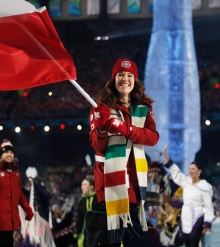Canada's Maple Leaf flag turns 50, middle age still gives off a nice red glow
Clara Hughes was nervous. The five-time Olympic medallist was just about to carry the Canadian Maple Leaf flag into the opening ceremony of the 2010 Winter Olympics in Vancouver.
But the speedskater and cyclist — who would go on to win her sixth Olympic medal at those games — wasn't quite sure what to do.
"I didn't want to drop the flag or look like a fool wondering if I should hold it with two hands or one, or put it in the holster," she says, looking back.
"Nobody briefs you on these sorts of things."
A volunteer gave her the flag, and the stadium went silent. She held her breath, and started waving the flag back and forth.
Then she looked up and saw the red leaf on the white background, and thought of all the Canadians watching and waiting for that moment.
"I remember feeling like the most beautiful maple leaf had fallen into my hands on an autumn day, bright red and so striking, and it was our flag," she says.
- Canada' flag's 50th anniversary a low-key affair
- CBC Archives: The great Canadian flag debate
- Joan O'Malley, first flag seamstress, to celebrate in Florida
"I took the step into our home Olympics not as myself, not even as an athlete or an Olympian, but as Canada."
Part of our psyche
Fifty years ago today, the red-and-white Maple Leaf design Hughes carried into the stadium became Canada's new national flag.
'Don't drop it'
When Hayley Wickenheiser was flag-bearer for the Canadian team at the opening ceremony for the 2014 Olympic Games in Sochi, the hockey player couldn't help but recall what another athlete had told her.
"What I remember most is repeating over and over in my head the advice from Clara Hughes. 'Just don’t drop it. Don’t let it touch the ground.'"
Now, Wickenheiser says people she has met associate the Maple Leaf with empathy, generosity and kindness. "Words can’t do it justice."
And in the five decades since, the image that captivated Hughes that rainy evening in February 2010 seems to have captured a country, in large part perhaps because its unique iconography arrived just as Canada was coming into its own as a nation.
"I just think it's part of our psyche," says Jane Yealland, co-author with Ann-Maureen Owens of the children's book, Our Flag: The Story of Canada's Maple Leaf.
"You look at other countries, like New Zealand and Australia, who are really struggling with this problem because they feel in part that their flag doesn't really identify them as a country."
But go just about anywhere in the world, and the stark Maple Leaf design that was adopted after a contentious debate has become instantly recognizable as a symbol of Canada.
"I think there's certainly something to be said about having a flag that is quite distinctive," says Yealland. "It's very much our flag."
Keep the Red Ensign
Not that everyone felt so good about it half a century ago.
"The flag was very divisive," says Nelson Wiseman, a University of Toronto politics professor.
Wiseman recalls, as an 18-year-old, seeing then prime minister Lester Pearson booed by members of the Royal Canadian Legion at a gathering in Winnipeg.
These veterans had no interest in having the Red Ensign — the British-influenced flag of the day, and the one under which they had fought in world wars — being replaced.
But post-war Canada was changing, distancing itself from its colonial roots as part of an evolution that had been building for decades, through political, legislative and social change.
The '60s were also a heady time and ripe for a different kind of nationalism. Not so long after the flag was adopted, Canada hosted the world for Expo 67 in Montreal, on the 100th anniversary of Confederation.
"This was a really big thing because the world was now coming to Canada," says Wiseman. "Canada had never hosted such a thing, and it was very avant garde."
What's more, outside Canada, the Maple Leaf was telling its own story.
Yealland remembers going to Europe in the early 1970s with a Maple Leaf on her backpack, and where there were still strong memories of Canadians as a liberating force in the Second World War.
It was a time when hitchhiking was still OK, and people would tell her "I stopped to pick you up because I saw the Maple Leaf."
It was, she says, all quite powerful. "We always heard that joke that the Americans were doing the same thing" — stitching the Canadian flag on their backpacks because the Maple Leaf had a more friendly reception.
"I don't know if that's still the same."
Currency abroad
Shirley Tillotson, a Canadian history professor at Dalhousie University in Halifax, also isn't sure about the symbolism the Maple Leaf holds today on the world stage.
"I think that gets made and remade with successive foreign policy and military behaviour," she says.
"I don't know how long memories are in different parts of the world about how well we've done since the 1960s in terms of our international citizenship, but it certainly doesn't have the complicated heritages of the Stars and Stripes or the Union Jack, so it's a little cleaner."
Wiseman is also not sure how much a flag on a backpack would help these days, in certain parts of the world at least.
"If you show up in Syria they're not going to be fussy about whether you're Canadian, German, American, Australian or Japanese. They'll kidnap you if that's what they want."
Still, Tillotson argues the Maple Leaf has succeeded as a flag, something that doesn't always happen with modernist designs.
It's a solid, bold, simple, design that references nature and the wilderness and the kinds of things Canadians like, she says.
"It’s not militaristic or religious, so it's not divisive on these kinds of grounds either."
Hughes would argue there's a strong unifying force around the flag.
"You definitely get a different perspective as an athlete wearing the Maple Leaf around the globe," she says.
She remembers, as a young cyclist, "so many random Canada moments" along the roadside when French, Dutch or Belgian spectators would come up to thank Canadian athletes for the actions of Canadian soldiers in war half a century before "just because that Maple Leaf was on our uniform."
"It happened too many times to ignore," says Hughes. "Being young and just wanting to be good at my sports, it made me start thinking about what it means to be Canadian, beyond politics and power."
Comments
There are 0 comments on this post













